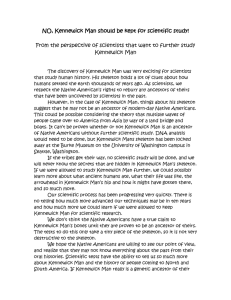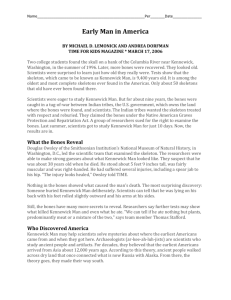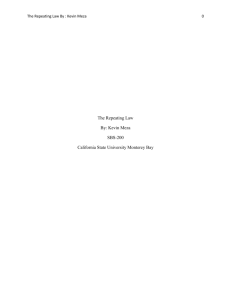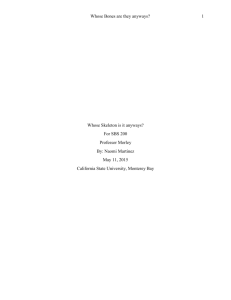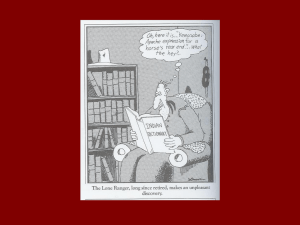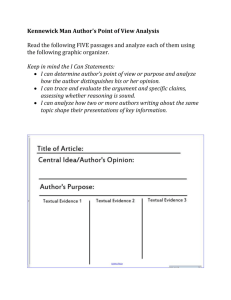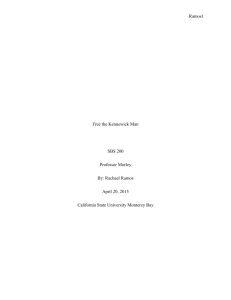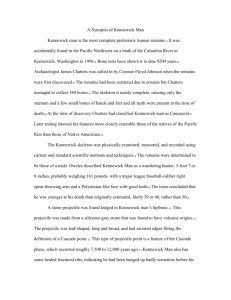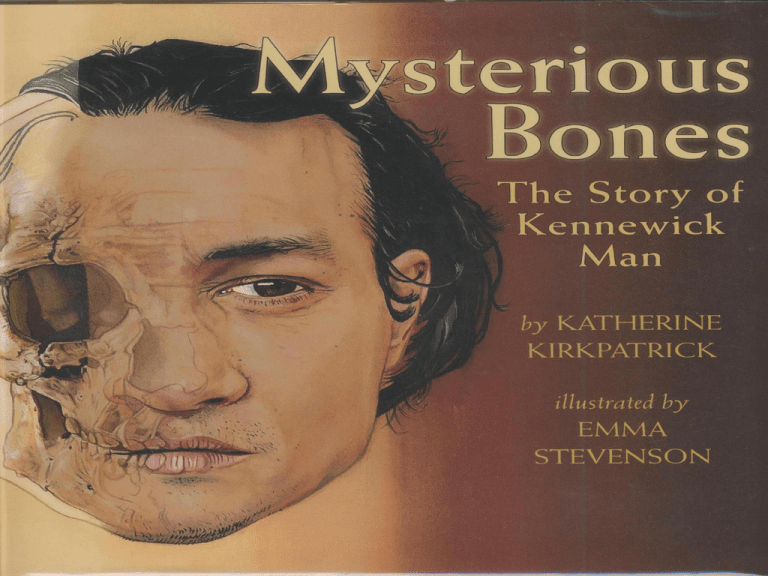
Link
• Show this video on the Kennewick Man that
aired on 60 Minutes in 1997
https://www.youtube.com/watch?v=vOTk3yDvk
gM
• Show the first minutes of this PBS Nova
episode on Kennewick Man:
https://www.youtube.com/watch?v=6iklMcO2xr
U
Two young men, Will Thomas and Dave Deacy,
discovered Kennewick Man’s skull at Columbia
Park in Kennewick, Washington while sneaking
into a hydroplane race on July 28, 1996.
Controversy
•
•
•
Anthropologist James (Jim)
Chatters was assigned to
investigate the bones.
U.S. Army Corps of Engineers
originally had legal custody of
Kennewick Man.
Confederate Tribes of the Umatilla
Indians, whose ancestors had
lived in the area, wanted to gain
custody of Kennewick Man.
Controversy
•
•
•
DNA was inconclusive but radiocarbon testing
indicated he had lived approximately 9,500 years
ago.
Umatilla Confederacy wanted to rebury Kennewick
Man according to their culture’s traditions.
Chatters believed Kennewick Man predated
Umatilla and that reburial without study would
disrespect his people’s proper place in human
history.
Why Study Skeletons?
• Medical students--To learn how bodies are constructed and how they
work so as doctors they can help people recover from accidents and
illnesses.
• Physical anthropologists--To determine person’s age, sex, how long
ago he or she died, whether the person had injuries or diseases and
in general, what the person looked like.
• Paleoanthropologists—To learn about the origins and anatomy of
early humans; to learn how humans evolved and adapted to their
environment.
What is Race?
Three skull shapes representing three major races
is concept from 1800’s, considered too simplistic
and out of date by modern anthropologists.
Modern peoples
often look different
from their ancestors.
Even by studying
Kennewick Man’s skull
shape, physical
anthropologists
cannot place him in
any modern-day racial
or ethnic category.
NAGPRA
Native American
Graves Protection
and repatriation
Act (NAGPRA)1990 law to
protect graves of
Native Americans
from being
disturbed.
NAGPRA
Intended to ensure
that remains of
Native Americans’
ancestors, along
with burial items,
would not be
owned as property
by museums or
government
agencies without
prior permission.
Nine-Year Court Battle
• Army Corps of Engineers planned to return bones to
Umatilla, citing NAGPRA.
• October, 1996, lawyers for eight scientists denied
right to further study Kennewick Man, sue. They
argue the government had not correctly followed
NAGPRA because skeleton was too old to be
identified as ancestor of any modern-day group.
• Lawyers for Corp countered that any skeleton older
than Christopher Columbus’s arrival (1492)
automatically classified as Native American.
Nine-Year Court Battle
• Case know as: Bonnichsen et al v. the United States
of America.
• August, 2002- Judge John Jelderks in Portland, OR,
rules that Army Corps must make bones available
for study.
• February, 2004-U.S. Court of Appeals unanimously
upholds Jelderks’s decision. Justice department and
tribes decide not to appeal to U.S. Supreme Court.
• January/February 2006-Scientists study Kennewick
Man.
Testing the Skeleton
• Scientists tried DNA testing to find out
how closely he is or is not related to other
ancient populations.
• DNA can be found in teeth and bones, but
much more easily in blood, urine, hair, skin
tissue and organs.
• Cell matter degrades over. Also, if bones
come in contact with other DNA (others
handling bones or animals contacting
bones) tests can be sabotaged.
• Thus far, efforts to test Kennewick Man’s
DNA has been unsuccessful.
• Other tests and observation of skeleton
have led scientists to other conclusions.
What you can determine from a skull:
What you cannot determine from a skull:
Proportional arrangements of facial
features
Approximate age
Sex
Teeth-individual characteristics and
conditions
Injuries, malnutrition and some
illnesses
Approximate weight
Possible indicators of ancestry
Skin color and freckles or other
markings
Wrinkles or other lines on skin
Hair color, type and style
Facial hair (mustache, beard)
Eyebrows and eyelid structure
Eye color
Shape and length of nose
Shape of ears
Shape of lips and mouth
Scientist Findings (as of 12/2011)
• Kennewick Man had been
about 5’9” or 5’10” tall.
• Bone mass showed he had
been very muscular and strong.
• He had arthritis in both knees
as well as in his right elbow and
in some vertebrae.
• Had been hit in the front of the
hip by an assailant throwing a
spear, but not fatal.
• Hip bone had grown back
around the spear point.
Other Theories and Findings
Most scientists believe Kennewick Man most closely related to ancient Polynesians or
Ainu, generally light-skinned (not Caucasian) people from Asia. People that migrated
to America’s during last ice age, either by land bridge or by boat.
Other Theories and Findings
Approximately 40
human remains
dating from 9,000
years ago or earlier
have been
reported in North
America.
Kennewick Man
rare for skull being
in such good
condition and set
of bones nearly
intact.
Kennewick Man’s Tool Kit
1. Lump of red ocher to make
designs on bodies or rocks,
decorate deceased before burial
or as insect repellant.
2. Crescent (fragment here;
archaeologists don’t know
purpose.
3. 3a and 3b-scrapers for shaping
bone and wood.
4. Bone needle for sewing.
5. Bola-set of stones tied together
to stun or snare birds and longlegged animals.
Kennewick Man’s Tool Kit
6. 6a-d- spear points for
killing game animals (and
also sometimes used as
knives for cutting).
6e is set to a foreshaft
with sinew or animal
tendon.
7. Barbed harpoon point,
possibly for spearing fish.
May have fastened to
foreshaft to use as spear.
What does story of Kennewick Man
mean for the future?
Currently, Kennewick Man is in special protective storage at the
Burke Museum in Seattle.
Case has raised moral, ethical and legal questions for future—
• Who should determine treatment of ancient human remains?
• What are potential benefits of knowledge and education in
relation to these remains?
• Do benefits outweigh considerations for respecting customs
and traditions?
• What values do all people share?
• How do we make decisions with groups of people of different
backgrounds and beliefs?
Update-October, 2012
Kennewick Man not from Columbia
Valley, scientists tell tribes
Isotopes in the bones told
scientists Kennewick Man was a
hunter of marine mammals, such
as seals, Owsley said. "They are
not what you would expect for
someone from the Columbia
Valley," he said. "You would have
to eat salmon 24 hours a day and
you would not reach these values.
Update-October, 2012
Clay model made from
Kennewick Man skull
"This is a man from the coast, not
a man from here. I think he is a
coastal man."
Rex Buck, leader of the Wanapum
people, told Owsley he
appreciated the presentation, but
that lamprey eel could provide the
same types of marine-mammal
nutrients that Owsley noted. "I
hope you would think about some
of these things, too, and add that
to your equation."
Links
• This video aired in 2014 on CBS Sunday
Morning:
https://www.youtube.com/watch?v=S0BJL4MX
DcM

